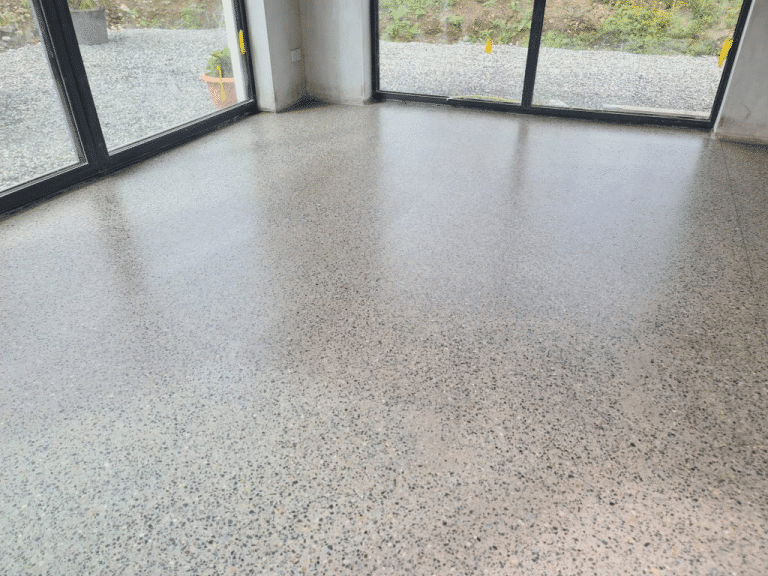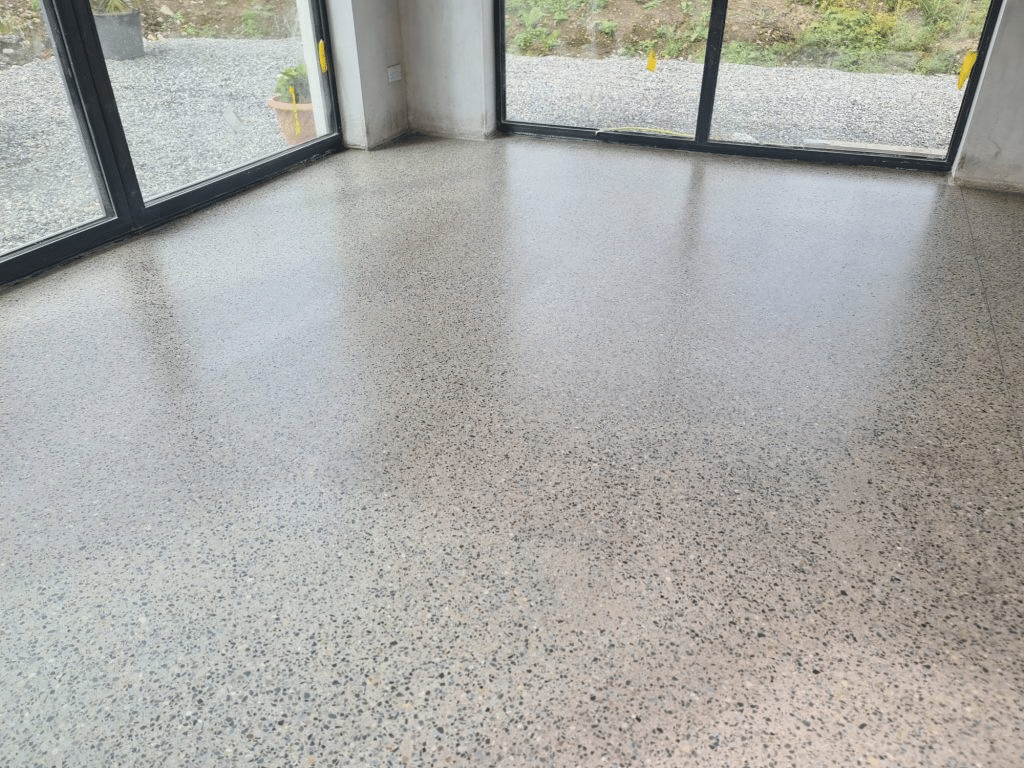Polished concrete is attracting growing interest in both interior and exterior design projects. Long reserved for industrial environments, this coating has won over individuals with its modernity, robustness, and ability to elegantly transform a space.
But before opting for this material, several factors deserve careful consideration. Its installation, aesthetic benefits, and technical constraints must be clearly defined to ensure a satisfactory and lasting result.
A contemporary and timeless aesthetic at the same time
One of the primary appeals of béton ciré lies in its ability to enhance a space without visually weighing it down. The absence of visible joints and the surface continuity it allows give rooms a feeling of spaciousness and modernity.
This characteristic makes it particularly suited to small spaces, which it subtly appears to enlarge. Its palette of natural or mineral hues easily harmonizes with different decorating styles, from the most refined to the most sophisticated.
This apparent simplicity, however, conceals a wealth of finishes. Some choose a smooth, satiny texture for a sober ambiance, while others prefer a more raw effect reminiscent of industrial lofts. Each project can thus find its own expression thanks to the versatility of this material. Its visual presence never tires, as it elegantly adapts to evolving trends and tastes.
A material resistant to the constraints of everyday life
One of the essential criteria in choosing a coating remains its resistance to wear. beton ciré rigorously meets this requirement, especially when it benefits from careful installation and adequate surface treatment.
Once protected with a suitable varnish or resin, it resists humidity, stains, and light impacts. This durability explains why it is increasingly used in technical rooms such as kitchens and bathrooms.
However, this solidity is not automatic. It relies on a demanding installation protocol, carried out in several layers, which must be entrusted to an experienced professional. Incorrect dosage, a poorly prepared surface, or hasty application can compromise the longevity of the coating. This observation encourages prioritizing skill over immediate savings. A poorly executed project could lead to costly repairs in the medium term.
Adaptability to different surfaces of the house
Polished concrete isn’t limited to floors. It can also be used on walls, stairs, countertops, and even furniture. This ability to be applied to a variety of surfaces, such as raw concrete, tiles, plaster, or wood, significantly expands its application possibilities. The visual uniformity it provides helps create a serene and cohesive atmosphere throughout the living space.
This versatility, however, requires rigorous adaptation depending on the intended surface. A tiled floor, for example, must be perfectly leveled to prevent any subsequent cracking. A wall, on the other hand, must provide a perfectly stable base.
These technical requirements must be met without compromise, otherwise early damage may appear. A proper diagnosis before the construction site can avoid unpleasant surprises after commissioning.
Simplified but rigorous maintenance
Contrary to popular belief, polished concrete is not a maintenance-free coating. Its surface, although protected, remains sensitive to harsh products. Therefore, it’s best to use neutral, non-abrasive cleaners to preserve its shine. Regular maintenance helps keep the material’s appearance intact and extend its lifespan.
In some cases, surface renovation may be necessary after a few years. This will not involve a complete replacement, but rather a new application of the protective layer. This process remains accessible and quick, provided the initial installation steps have been followed. This point once again underlines the importance of professional implementation, which guarantees the quality of the material over the long term.
An economical solution over time
The initial cost of polished concrete may seem high compared to other, more traditional coatings. However, its exceptional durability, combined with the reduced need for frequent renovation, makes it a cost-effective long-term solution. The absence of joints also limits the growth of mold and facilitates maintenance, reducing the need for upkeep.
This profitability must be analyzed in light of the intended use and exposure of the coating. A high-traffic area, such as a hallway or kitchen, fully benefits from the qualities of polished concrete. The initial investment translates into user comfort and lasting peace of mind, appealing to a public seeking reliable and long-lasting solutions.
A responsible choice for the environment
Polished concrete can also meet ecological requirements, under certain conditions. Manufacturers now offer formulations that reduce the amount of synthetic resins, favoring more environmentally friendly mineral components. This approach is part of a sustainable and responsible construction approach, in line with new societal expectations.
However, the ecological impact of a material isn’t limited to its composition. The production method, transport distance, and product lifespan also come into play. Choosing polished concrete from a short supply chain or manufactured using eco-friendly processes is a step toward a more sustainable development. This attention to detail demonstrates a concern for balance between aesthetics, functionality, and environmental awareness.
Constraints to anticipate before installation
Polished concrete requires meticulous surface preparation. Any flaws or irregularities can be visually reflected once the final coat is applied. Therefore, the installation process requires patience and precision. Furthermore, the drying time between coats varies depending on ambient conditions, which can sometimes lengthen the project duration compared to other types of coatings.
This time constraint can put off some project leaders who want immediate results. However, this wait is the price to pay for a flawless result, which adds lasting value to the space being developed. It’s best to anticipate these delays in the overall organization of the work to ensure that the final result lives up to initial expectations.
Calling on a qualified professional: a necessity
There’s no room for error when applying polished concrete. Mastery of the technique, product knowledge, and the ability to adapt to the constraints of the construction site determine the quality of the result. Contacting a trained craftsman or a specialized company is therefore an essential guarantee.
This approach also provides reassurance in the event of unforeseen technical issues. A crack in the substrate, a change in humidity, or a lack of leveling are all factors that only an experienced professional can correct. Hiring an expert isn’t just a matter of convenience; it’s essential to ensure the long-term viability of an often substantial investment.










